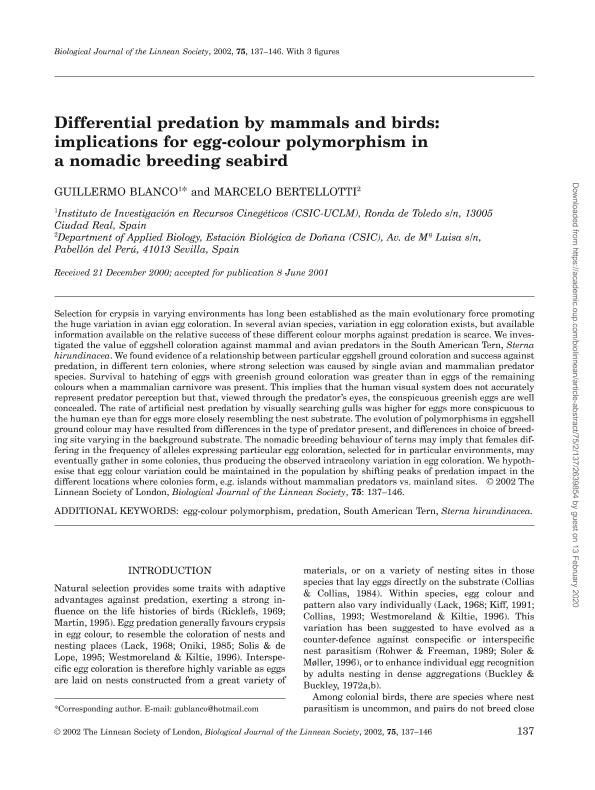Mostrar el registro sencillo del ítem
dc.contributor.author
Blanco, Guillermo
dc.contributor.author
Bertellotti, Néstor Marcelo

dc.date.available
2020-02-13T20:32:59Z
dc.date.issued
2002-02
dc.identifier.citation
Blanco, Guillermo; Bertellotti, Néstor Marcelo; Differential predation by mammals and birds: Implications for egg-colour polymorphism in a nomadic breeding seabird; Oxford University Press; Biological Journal of The Linnean Society; 75; 2; 2-2002; 137-146
dc.identifier.issn
0024-4066
dc.identifier.uri
http://hdl.handle.net/11336/97484
dc.description.abstract
Selection for crypsis in varying environments has long been established as the main evolutionary force promoting the huge variation in avian egg coloration. In several avian species, variation in egg coloration exists, but available information available on the relative success of these different colour morphs against predation is scarce. We investigated the value of eggshell coloration against mammal and avian predators in the South American Tern, Sterna hirundinacea. We found evidence of a relationship between particular eggshell ground coloration and success against predation, in different tern colonies, where strong selection was caused by single avian and mammalian predator species. Survival to hatching of eggs with greenish ground coloration was greater than in eggs of the remaining colours when a mammalian carnivore was present. This implies that the human visual system does not accurately represent predator perception but that, viewed through the predator's eyes, the conspicuous greenish eggs are well concealed. The rate of artificial nest predation by visually searching gulls was higher for eggs more conspicuous to the human eye than for eggs more closely resembling the nest substrate. The evolution of polymorphisms in eggshell ground colour may have resulted from differences in the type of predator present, and differences in choice of breeding site varying in the background substrate. The nomadic breeding behaviour of terns may imply that females differing in the frequency of alleles expressing particular egg coloration, selected for in particular environments, may eventually gather in some colonies, thus producing the observed intracolony variation in egg coloration. We hypothesise that egg colour variation could be maintained in the population by shifting peaks of predation impact in the different locations where colonies form, e.g. islands without mammalian predators vs. mainland sites.
dc.format
application/pdf
dc.language.iso
eng
dc.publisher
Oxford University Press

dc.rights
info:eu-repo/semantics/openAccess
dc.rights.uri
https://creativecommons.org/licenses/by-nc-sa/2.5/ar/
dc.subject
EGG-COLOUR POLYMORPHISM
dc.subject
PREDATION
dc.subject
SOUTH AMERICAN TERN
dc.subject
STERNA HIRUNDINACEA
dc.subject.classification
Ecología

dc.subject.classification
Ciencias Biológicas

dc.subject.classification
CIENCIAS NATURALES Y EXACTAS

dc.title
Differential predation by mammals and birds: Implications for egg-colour polymorphism in a nomadic breeding seabird
dc.type
info:eu-repo/semantics/article
dc.type
info:ar-repo/semantics/artículo
dc.type
info:eu-repo/semantics/publishedVersion
dc.date.updated
2020-02-11T17:58:01Z
dc.journal.volume
75
dc.journal.number
2
dc.journal.pagination
137-146
dc.journal.pais
Reino Unido

dc.journal.ciudad
Oxford
dc.description.fil
Fil: Blanco, Guillermo. Consejo Superior de Investigaciones Científicas. Museo Nacional de Ciencias Naturales; España
dc.description.fil
Fil: Bertellotti, Néstor Marcelo. Consejo Nacional de Investigaciones Científicas y Técnicas. Centro Nacional Patagónico; Argentina
dc.journal.title
Biological Journal of The Linnean Society

dc.relation.alternativeid
info:eu-repo/semantics/altIdentifier/doi/http://dx.doi.org/10.1046/j.1095-8312.2002.00026.x
dc.relation.alternativeid
info:eu-repo/semantics/altIdentifier/url/https://academic.oup.com/biolinnean/article/75/2/137/2639854
Archivos asociados
